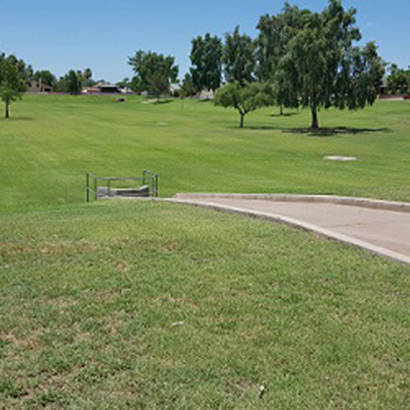
While it doesn’t rain much in the desert southwest, communities must still prepare accordingly for the summer monsoon season and the occasional winter rains. To manage the run off from these storms, water retention is managed through a series of strategically located retention basins. In Mesa, Arizona many of these large basins also serve as parks and recreation amenities for the community to use. While some basins are simple turfed open play areas, others include playgrounds, picnic ramadas, and basketball courts and truly function as a neighborhood park. 52% of the total property maintained by Mesa’s Parks, Recreation and Commercial Facilities (PRCF) Department is classified as a basin and contain a series of drains and pumps to move the water accordingly when flooding/retention occurs.
In 2007, the City of Mesa established an Environmental Compliance Fee to fund environmental mandates that improve air quality, reduce storm water pollution and insure compliance with other public health related programs. Mesa had traditionally managed environmental mandates with General Fund revenues. Unfunded federal and state mandates require the City to manage environmental issues in ways that protect and/or improve water and air quality and that address other public health issues. The fee is a flat rate and each utility customer regardless of water use, property value, or the type of account, pays the same amount. The current fee has been established to fully recover the costs of the federal and state regulatory mandates.
As the City was in the depths of the great recession Mesa PRCF was identifying ways to continue or improve maintenance practices in the parks system without increasing contributions from the general fund. As part of the 2011 process, Mesa PRCF Director, Marc Heirshberg, proposed that the Department be allocated funding from the Environmental Compliance Fee for basin maintenance to ensure that they were maintained accordingly so that drains remained level and the turf was healthy to ensure that the water continues to flow to the drains without extensive sediment buildup.
The City Manager and City Council agreed with the recommendation and also agreed not to reduce the departments general fund appropriation as those expenses were transferred to the Environmental Compliance Fee. The result was essentially a $6 million annual increase in park maintenance for the remaining 47% of the property maintained by PRCF. The results are evident as parks and basins throughout the City are maintained at a consistent level and have resulted in improved turf health, increased maintenance of trees and healthy shrubs and plant material. Director Marc Heirshberg credits the allocation with the rejuvenation of Mesa’s parks. “This (allocation of the Environmental Compliance Fee) laid the groundwork for increasing the care and maintenance provided to the property’s maintained by the PRCF Department. With residents seeing first hand results there continues to be increased public support to find ways to finance improvements and ongoing maintenance for Mesa’s Parks and Recreation amenities.”
Today, the monthly fee is $7.32/month per customer and is evaluated annually to ensure that current maintenance levels continue. In addition, the City Council has indicated that depending on impact to the fee paid by utility customers, they would be willing to increase the fee to help provide funding for capital improvements. This would allow Mesa the opportunity to upgrade aging irrigation pumps and systems to improve operational efficiency.
This shift in funding mechanisms has in many ways been a game changer for the Mesa parks system. As part of previous budget reductions, watering was reduced, fertilizing was eliminated or reduced and general maintenance (mows, trimming, etc.) were reduced. By utilizing the Environmental Compliance Fee, Mesa has been able to restore maintenance levels, beautify the parks system, maintain a healthy storm water retention system and most importantly restored the public’s confidence that their parks are being maintained at high level.
